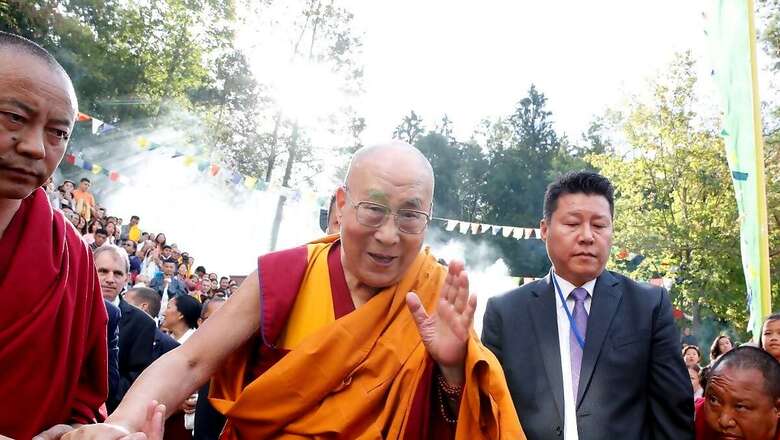
views
China has been blocking His Holiness the Dalai Lama’s visits to Sri Lanka. Recently, a renowned Sri Lankan Buddhist monk revealed this in a media interview. When asked about China’s view on the Dalai Lama, the most venerable Dr. Waskuduwe Mahindawansa said, “We respect him and invited him to Sri Lanka, but China did not like that. China pressed against our government as well, we don’t like that. He is a Buddhist leader, he has freedom, and we have the freedom to invite.”
This incident wasn’t an exception; China has been blocking His Holiness the Dalai Lama’s visits to Sri Lanka since 2015. In fact, China has never shied away from expressing its displeasure whenever the Dalai Lama moves from one place to another or meets any person of repute. For China, the Dalai Lama, who was awarded the Nobel Peace Prize in 1989, is a ‘separatist’. China has even called him ‘wolf in monk’s robes’.
Why does a benevolent exiled leader agitate an aspiring superpower so much? The answer lies in the complex history of Tibet and the Chinese subjugation of the same over the last 70 years.
Tibet: A Brief History
Tibet lies in the confluence of Central, South and East Asia. It has a recorded history dating back to 602 AD when Namri Songsten became the first king of Tibet, uniting the central Tibetan states. There are records of conflict between China and Tibet, which was ended by the China-Tibet Peace Treaty 821 AD. The treaty famously mentions, “Tibetans shall be happy in Tibet, and Chinese shall be happy in China.” After more than 700 years, China and Tibet both sustained subsequent Mongol invasions. In the latter half of the 16th century, Altan Khan, the Mongol ruler, gave the title of Dalai Lama to Sonam Gyatso, leader of the Gelugpa school of Buddhism. In return, the Dalai Lama decreed that Altan Khan be reincarnated as Kublai Khan, which gave legitimacy to his rule. This event marks the founding of modern Tibet. For the next two hundred years Chinese tried to take hold of Tibet but could not succeed, and their influence declined in the first half of the 20th century.
In 1912, the Qing emperor of China renounced his post, giving way to the establishment of the Republic of China. China also lost whatever suzerainty it had over Tibet, and the Dalai Lama reiterated that, “We are a small, religious, and independent nation.” In 1914, Britain, Tibet, and China met in Shimla to negotiate the borders between British India and Tibet. In that treaty control of Qinghai was given to China, and the rest of Tibet was recognised as autonomous.
Thereafter Tibet enjoyed a relatively peaceful three decades until China invaded it again after the end of the Chinese civil war in 1950. The new People’s Republic of China initially gave the 14th Dalai Lama (Tenzin Gyatso) complete authority over Tibet. However, widespread Chinese brutality on Tibetans continued which finally resulted in the Tibetan National Uprising of 1959. In March 1959, Chinese troops attacked the Potala Palace in order to arrest the Dalai Lama, but he managed to escape to India.
Today plenty of evidence of Chinese high-handedness while dealing with the Tibetan Uprising are available online. Since then, the Dalai Lama has extended multiple proposals toward China for peaceful engagement, which has always been ignored and subjected to blatant personal attacks by Chinese authorities.
Dalai Lama: A Smile of Resistance
Since 1960, His Holiness the Dalai Lama has been heading or guiding the Tibetan government in exile from Dharamshala and is one of the most substantial hopes for the 7 million Tibetans living under the oppressive Chinese regime. The Dalai Lama has carved a niche for himself for not being just a religious head but also as a symbol of resistance, which is non-violent, supportive and talks about love and care among people. It gives the Dalai Lama a distinguished reputation worldwide. His teachings navigate through the ideas of joy and happiness and how to channel one’s emotions for the better. Since the late 1970s, the Dalai Lama has travelled from one continent to another spreading the wisdom of Buddha worldwide. He has followers worldwide, ranging from Hollywood superstars to politicians, diplomats and intellectuals from various corners of the world.
This immense popularity of the Dalai Lama presents a phenomenal challenge to the Chinese regime accused of cultural genocide in Tibet. The CCP has an official ideology which thinks of religion as an ‘opium of the masses’. Its political leaders have defined religion as ‘foreign cultural imperialism’, ‘feudalism’ and ‘superstition’. The Chinese regime seems to be fearful of the aura and popularity of His Holiness the Dalai Lama. It is suspected that a visit of the Dalai Lama to other countries would bring the Tibetan cause to the forefront and expose its repressive regime.
Thus, China has been repeatedly using its economic clout and influence to curtail the popularity of the Dalai Lama. The repeated attempts by China to stop his holiness visit to Sri Lanka is part of the same playbook. The way the Chinese government has arm-twisted Sri Lanka to stonewall the visit of an esteemed Buddhist spiritual leader is a matter of serious concern. It has again brought to the forefront widely known folly of smaller economies walking into the Chinese ‘Debt Trap’ losing their sovereignty.
The writer is an author and columnist and has written several books. His X handle is @ArunAnandLive. Views expressed in the above piece are personal and solely that of the author. They do not necessarily reflect News18’s views.




















Comments
0 comment